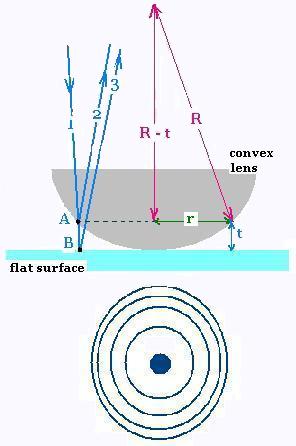Contents
ScientificSentence
© The scientific sentence. 2010
|
Optics: Newton's rings
1. Newton's rings
 The device to produce Newton's rings contains
A flat surface, a convex lens (spherical surface) with
an air wedge formed between them. The lens is
illuminated with normally incident monochromatic light (ray 1). The
circular fringes viewed are concentric circles around the point of
contact with the flat surface.
The device to produce Newton's rings contains
A flat surface, a convex lens (spherical surface) with
an air wedge formed between them. The lens is
illuminated with normally incident monochromatic light (ray 1). The
circular fringes viewed are concentric circles around the point of
contact with the flat surface.
R is the radius of curvature of the lens,
T is the thickness of the lens where we
choose r.
Pythagorean theorem gives:
r2 + (R - t)2 = R2
Therefore
r2 + t2 - 2 R t = 0
Because it is small, we neglect the term t2, hence:
r2 = 2 R t , or
t = r2/2R
t = r2/2R
(1)
At the point A, th reflected ray does not undergo a phase change, but
at the point B the reflected ray 2 undergoes a π phase change.
Therefore
Δφ = φ3 - φ2 = (φB + φ(t)) - φA
The path difference between reflected rays is δ = 2t
φ(t) = 2 π δ/λ = 4 π t/λ
Hence:
Δφ = (π + (4πt/λ)) - o =
π(1 + (4t/λ))
1.The bright fringes corresponds the constructive
interferences and a phase difference of 2 m π. That
is:
2 m π = π(1 + (4t/λ))
Hence:
2 m = (1 + (4t/λ)), or:
t = (2 m - 1)λ/4
t = (2 m - 1)λ/4
(2)
2. The dark fringes corresponds the destructive
interferences and a phase difference of (2 m + 1) π. That
is:
(2 m + 1) π = π(1 + (4t/λ))
Hence:
2 m = 4t/λ), or:
t = mλ/2
From equation (1), the radius r of the m-th ring corresponds to the
thickness of the air wedge t :
r = (2 R t )1/2
The bright m-th ring corresponds to
r = (2 R t )1/2 = [R (m - 1/2)λ]1/2
(3)
The dark m-th ring corresponds to
r = (2 R t )1/2 = (R mλ)1/2
(4)
The bright m-th ring corresponds to:
r = [R (m - 1/2)λ]1/2
The dark m-th ring corresponds to:
r = (R mλ)1/2
Remarks:
1. The index of refraction of the lens has no important.
2. The index of refraction of air is n = 1 that gives:
λ (in air) = λ(in vacuum) = λ
2. Example
If the incident light has a lambda; = 500 nm, and R = 2.00 m,
what is the radius of the 4th bright ring ?
r = [R (m - 1/2)λ]1/2 =
[2.00 (4 - 1/2)5 x 10 -7>]1/2 =
18.71 x 10 -4> m = 1.9 mm.
|
|